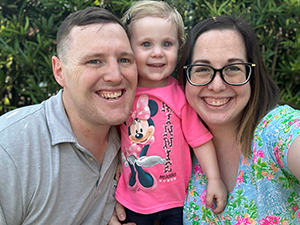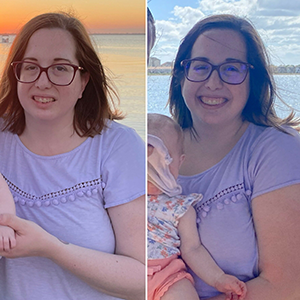 A few months before I had my daughter in the summer of 2021, I started noticing facial weakness. This led to me being unable to smile for extended periods of time, difficulty chewing, and even difficulty drinking out of a straw. I didn’t realize how abnormal this was until about a week after I got home from the hospital and noticed my speech slurring. All of my previous symptoms began to worsen as well.
A few months before I had my daughter in the summer of 2021, I started noticing facial weakness. This led to me being unable to smile for extended periods of time, difficulty chewing, and even difficulty drinking out of a straw. I didn’t realize how abnormal this was until about a week after I got home from the hospital and noticed my speech slurring. All of my previous symptoms began to worsen as well.
This started me down a long journey that involved multiple doctors, tests, bloodwork, and a deep fear that I would never find out what was wrong and why my body would not cooperate. All of this was going on in the background of my maternity leave and return to work, while also adjusting to being a mom.
For the entire month of October 2021, I feared I had MS, as the neurologist wanted to rule that out. I had numerous tests, MRIs, and about a gallon of blood drawn for tests. We learned that I thankfully did NOT have MS, but we still didn’t know what it was.
Without a doubt, not being able to consistently smile was the most difficult for me emotionally. In countless pictures I look like I am grimacing, despite my best attempts to smile. All of my symptoms were fairly intermittent, but happened almost every day for months on end. Multiple medical practitioners told me it was likely stress. One mentioned long Covid. Several mentioned postpartum hormone shifts. No one really knew. In December my neurologist said to track my symptoms and come back in three months, but shortly afterwards things started to take a turn for the worse.
Over Christmas break I developed hand and finger weakness. Once again, I was told not to worry. A couple of weeks after that, I caught Covid for the second time despite being fully vaccinated and boostered. The week I had Covid I noticed blurred vision, increased hand and finger weakness, continued issues with facial weakness, and my arms started to be affected as well. I kicked my research into overdrive, reading medical articles and scouring numerous websites to try to find an answer. The weakness began to worsen and spread beyond my wrists and fingers.
I concluded that the only illness that checked all the boxes was an incredibly rare autoimmune disease called myasthenia gravis (MG).
I contacted my primary care office and practically begged for an antibody test to rule out MG. She ordered the bloodwork, and I went a full anxious six days waiting for the results. The night before my follow up with the neurologist I got the bloodwork back… And it was astonishingly high for AChR binding antibodies – the most common antibody found in myasthenia gravis.
I took the blood work back to my neurologist, and he started a whole workup to either rule out or confirm MG. Part of that workup included starting a medication called Mestinon. He explained that if the medicine works, then I definitely have MG. Within hours of starting the medication I noticed an improvement. The two weeks that followed were like night and day to my previous eight months of symptoms.
In March 2022 I was formally diagnosed with generalized myasthenia gravis.
When you have MG, your body produces antibodies that make it difficult for your nerves to communicate with the affected muscles. Generalized MG usually starts with bulbar nerve symptoms, meaning it affects the face, hands, neck, fingers, and arms… Exactly what I experienced. MG is also a rare disease. Approximately 20 out of 100,000 people have it, which is likely part of why it takes two to three years on average to get a diagnosis.
 This is me and shows the impact MG has. The image on the left is from a week before my initial MG blood work came back. I had just eaten dinner, and we wanted to take some pictures on the pier during the sunset. I tried so hard to smile… And no matter what I did my facial muscles just wouldn’t cooperate.
This is me and shows the impact MG has. The image on the left is from a week before my initial MG blood work came back. I had just eaten dinner, and we wanted to take some pictures on the pier during the sunset. I tried so hard to smile… And no matter what I did my facial muscles just wouldn’t cooperate.
I was so devastated – the picture was beautiful, but I looked so unhappy. My muscles were not allowing me to convey my real emotions.
The picture on the right was the day after I started medication to treat the symptoms of MG. I was able to eat a meal without difficulty, drink through a straw, not slur my speech, and smile effortlessly. It was the most hopeful I had been in months.
The two main takeaways I have from this diagnosis journey are:
(1) Advocate for your health. Don’t take no for an answer. If you think something is wrong, you’re probably right. Don’t give up and don’t be afraid to research it yourself. Myasthenia gravis takes on average two to three years to get diagnosed. Other autoimmune diseases can take even longer (on average, four-ish years!). If I hadn’t researched, it likely would have been years before I was able to get treatment.
(2) Everyone has struggles going on behind the scenes. You often don’t see these on social media or even necessarily in daily interactions. We are all navigating this life and doing the best we can. Be kind to each other.
I had a thymectomy in April 2022 and am currently on a few different medications for my MG. I still am dealing with fatigue and muscle weakness, but I am so happy to finally be getting treatment for my symptoms. There is no cure, but MG is not a progressive illness. Many people are able to get good treatment and some even go into permanent remission.
Since my diagnosis I have given back to the MG community through volunteering with the Myasthenia Gravis Foundation of America to help ensure that no one else has to suffer with MG without a diagnosis or treatment. I also actively work to bring awareness to MG, including sharing my story with colleagues so they understand what it’s like to live and work with this disease.
I don’t know what the road ahead looks like, but I am so thankful to my friends and family who are supporting me during this journey!

